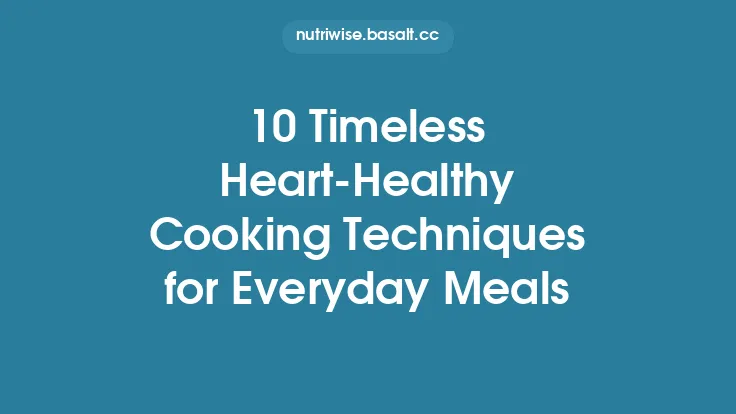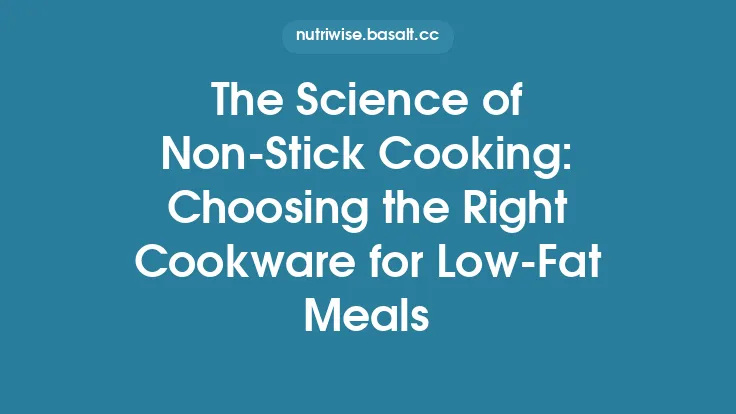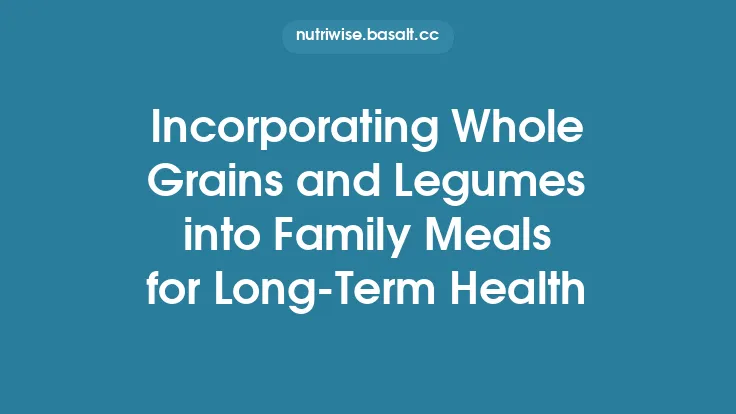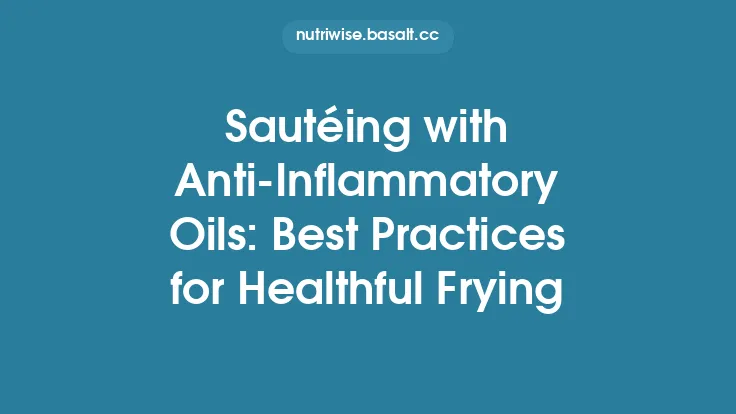Anti‑inflammatory cooking isn’t about a single trick or a fleeting trend; it’s a collection of time‑tested methods that coax the most health‑promoting compounds out of our foods while keeping meals practical for everyday life. Below are ten enduring techniques that, when woven into your routine, can help keep chronic inflammation at bay without sacrificing flavor or convenience.
1. Fermentation: Harnessing Beneficial Microbes
Fermentation transforms vegetables, grains, and dairy into probiotic‑rich powerhouses. The lactic‑acid bacteria that develop during the process not only preserve food but also produce short‑chain fatty acids (SCFAs) such as butyrate, which have been shown to modulate immune responses and reduce systemic inflammation.
Key steps for a successful ferment:
- Select high‑quality produce – fresh, organic vegetables retain more polyphenols and antioxidants.
- Create a brine – a 2–3 % salt solution (20–30 g salt per litre of water) draws out water, creating an anaerobic environment that favors beneficial microbes while inhibiting pathogens.
- Control temperature – aim for 18–22 °C (64–72 °F). Cooler temperatures slow fermentation, preserving crispness; warmer conditions speed it up but may produce off‑flavors.
- Allow sufficient time – most vegetable ferments reach peak flavor and probiotic density after 5–14 days, though some kimchi varieties benefit from a few weeks of aging.
Everyday applications: sauerkraut, kimchi, fermented carrots, miso, tempeh, and yogurt. Incorporate a spoonful into salads, sandwiches, or grain bowls for a tangy, gut‑friendly boost.
2. Pickling with Acidic Brines
Pickling, distinct from fermentation, relies on an acidic medium—typically vinegar—to preserve foods. The acidity not only extends shelf life but also enhances the bioavailability of certain phytochemicals, such as anthocyanins in red cabbage, by stabilizing their structure.
Tips for anti‑inflammatory pickles:
- Use apple cider or rice vinegar – both contain trace amounts of polyphenols and have a milder flavor profile that pairs well with herbs.
- Add anti‑inflammatory spices – turmeric, ginger, garlic, and mustard seeds contribute additional bioactive compounds.
- Balance sweeteners – a modest amount of raw honey or maple syrup can offset acidity without spiking blood sugar, especially when paired with low‑glycemic vegetables.
Practical ideas: quick‑pickled cucumbers for sandwiches, beet strips for salads, or pickled red onions to top tacos. Store in the refrigerator for up to a month.
3. Soaking, Sprouting, and Germination
Raw grains, legumes, and seeds contain phytic acid, an antinutrient that can bind minerals and diminish the absorption of zinc, iron, and magnesium—minerals essential for regulating inflammatory pathways. Soaking and sprouting reduce phytic acid while activating enzymes that increase the levels of vitamins C, E, and B‑complex.
How to sprout at home:
- Rinse the chosen seed (e.g., lentils, chickpeas, quinoa) thoroughly.
- Soak in cool water for 4–12 hours, depending on size.
- Drain and rinse, then place in a jar or sprouting tray.
- Rinse and drain twice daily, keeping the container in a dark, well‑ventilated spot.
- Harvest when sprouts reach 1–2 cm (usually 2–5 days).
Culinary uses: add sprouted lentils to salads, toss sprouted quinoa into stir‑fries, or blend sprouted beans into hummus for a smoother texture and heightened nutrient profile.
4. Mastering Anti‑Inflammatory Spice Blends
Spices such as turmeric, ginger, cinnamon, and black pepper are dense sources of polyphenols, flavonoids, and curcuminoids—compounds that inhibit NF‑κB, a key transcription factor in the inflammatory cascade. Combining them strategically can create synergistic effects.
Blend fundamentals:
- Base: turmeric (curcumin) – 2 parts
- Heat & depth: ginger or galangal – 1 part
- Sweetness & balance: cinnamon or cardamom – ½ part
- Enhancer: freshly ground black pepper (piperine boosts curcumin absorption) – a pinch per serving
- Optional: dried rosemary or oregano for additional antioxidant capacity
Application: rub the blend onto roasted root vegetables, stir it into soups after cooking (heat can degrade curcumin, so add near the end), or sprinkle over oatmeal for a morning anti‑inflammatory boost.
5. Cold Infusions and Raw Preparations
Heat can degrade heat‑sensitive nutrients like vitamin C, certain B‑vitamins, and delicate polyphenols. Cold infusion preserves these compounds while also delivering a refreshing, hydrating element to meals.
Techniques:
- Cold‑brew teas: steep green tea, rooibos, or herbal blends in cold water for 6–12 hours. The resulting beverage retains catechins and antioxidants without the bitterness that can develop with hot brewing.
- Infused waters: add slices of cucumber, lemon, ginger, or berries to a pitcher of filtered water. Let sit for at least 30 minutes; the gentle extraction yields flavonoids and vitamin C.
- Raw salads with acid dressings: combine raw leafy greens with a vinaigrette of lemon juice, apple cider vinegar, and a dash of olive oil. The acid “cooks” the greens slightly, making nutrients more accessible while preserving heat‑labile compounds.
Everyday tip: keep a jug of infused water in the fridge for quick access, and rotate flavor combinations weekly to keep the habit exciting.
6. Sous‑Vide: Precision Low‑Temperature Cooking
Sous‑vide (French for “under vacuum”) involves sealing food in a plastic bag and immersing it in a water bath held at a precisely controlled temperature, typically between 55 °C and 85 °C (130 °F–185 °F). This method minimizes oxidative stress on nutrients because the food never exceeds the set temperature, and the sealed environment prevents leaching of water‑soluble vitamins.
Benefits for inflammation:
- Retention of omega‑3 fatty acids in fish and nuts, which are prone to oxidation at high heat.
- Preservation of polyphenols in vegetables, especially when cooking times are extended at moderate temperatures (e.g., 60 °C for 45 minutes for carrots).
- Enhanced collagen extraction from bone‑in‑water preparations, yielding gelatin that supports gut lining integrity.
Practical use: sous‑vide salmon at 52 °C for 30 minutes with a drizzle of lemon and dill; sous‑vide sweet potatoes at 85 °C for 1 hour before a quick sear for texture.
7. Pressure Cooking: Speedy Nutrient‑Preserving Method
Pressure cookers raise the boiling point of water to about 121 °C (250 °F) under high pressure, dramatically reducing cooking times. Because foods spend less time exposed to heat, heat‑sensitive nutrients are better conserved compared to conventional boiling.
Key considerations:
- Use minimal liquid – just enough to generate steam; excess water can leach water‑soluble vitamins.
- Short cooking intervals – for legumes, 10–15 minutes at high pressure is sufficient; for leafy greens, 2–3 minutes preserves both texture and nutrients.
- Natural release – allow the pressure to drop naturally for delicate vegetables to avoid sudden temperature spikes that can degrade nutrients.
Everyday applications: pressure‑cooked lentil dal with turmeric and cumin; quick‑cook quinoa for salads; tenderized chicken breast for shredding into tacos.
8. Blanching Followed by Ice‑Bath Shock
Blanching briefly immerses vegetables in boiling water (1–3 minutes) then immediately transfers them to an ice bath. This technique halts enzymatic activity, preserving color, texture, and phytochemicals while also reducing the load of anti‑nutrients like oxalates.
Why it matters for inflammation:
- Inactivates myrosinase in cruciferous vegetables, which can otherwise convert glucosinolates into less beneficial compounds. When you later consume raw or lightly cooked cruciferous veggies, the preserved myrosinase helps generate sulforaphane, a potent anti‑inflammatory agent.
- Locks in water‑soluble vitamins by limiting exposure to heat.
Practical tip: blanch broccoli for 2 minutes, shock in ice water, then toss with a drizzle of walnut oil and a sprinkle of toasted sesame seeds for a quick anti‑inflammatory side.
9. Deglazing and Reducing with Anti‑Inflammatory Liquids
After sautéing or searing (brief, high‑heat steps that are permissible as long as they’re not the focus), a pan often holds browned bits (fond) packed with flavor. Deglazing with an acidic, antioxidant‑rich liquid extracts these compounds and forms the base for sauces that can further combat inflammation.
Ideal deglazing agents:
- Red wine (moderate polyphenols)
- Apple cider vinegar
- Citrus juice (lemon or orange)
- Pomegranate juice (high in punicalagins)
- Bone broth (rich in collagen and glycine)
Technique:
- Remove the main ingredient from the pan.
- Add ½‑1 cup of chosen liquid, scraping the fond with a wooden spoon.
- Simmer until reduced by half, concentrating flavor and allowing the liquid’s bioactive compounds to meld with the fond.
- Finish with a teaspoon of anti‑inflammatory oil (e.g., extra‑virgin olive oil) and a pinch of your spice blend.
Use cases: a quick mushroom‑and‑onion reduction for grilled chicken, a pomegranate‑vinegar glaze for roasted carrots, or a bone‑broth reduction for a hearty vegetable stew.
10. Incorporating Acid‑Alkali Balance Through Citrus and Fermented Condiments
The body’s internal pH can influence inflammatory pathways; diets overly rich in acid‑forming foods may promote a low‑grade inflammatory state. While the body tightly regulates systemic pH, dietary patterns that emphasize alkaline‑forming foods (vegetables, fruits) alongside modest acid sources can support overall metabolic health.
Strategic applications:
- Finish dishes with a splash of citrus (lemon, lime, grapefruit) to add alkalizing minerals like potassium and magnesium while providing vitamin C, which recycles other antioxidants.
- Use fermented condiments such as kimchi juice, sauerkraut brine, or miso paste to introduce both alkalizing amino acids and probiotic benefits.
- Balance meals by pairing protein‑rich, mildly acid‑forming foods (e.g., fish, poultry) with generous portions of leafy greens and a citrus‑based dressing.
Everyday example: a quinoa bowl topped with grilled salmon, a kale‑and‑avocado salad, and a lemon‑tahini drizzle; or a stir‑fry finished with a splash of miso‑lime sauce.
Putting It All Together
These ten timeless techniques are not isolated tricks; they interlock to create a culinary ecosystem that consistently delivers anti‑inflammatory benefits:
- Start with a base of soaked or sprouted grains/legumes for enhanced mineral absorption.
- Add fermented or pickled elements for probiotic support.
- Layer flavors using spice blends, citrus, and deglazed sauces rich in polyphenols.
- Choose cooking methods like sous‑vide, pressure cooking, or blanching to preserve nutrients.
- Finish with cold infusions or raw components to retain heat‑sensitive antioxidants.
By integrating these practices into your weekly meal planning, you’ll build a resilient diet that not only delights the palate but also equips your body with the tools it needs to keep chronic inflammation at bay—day after day, year after year.





